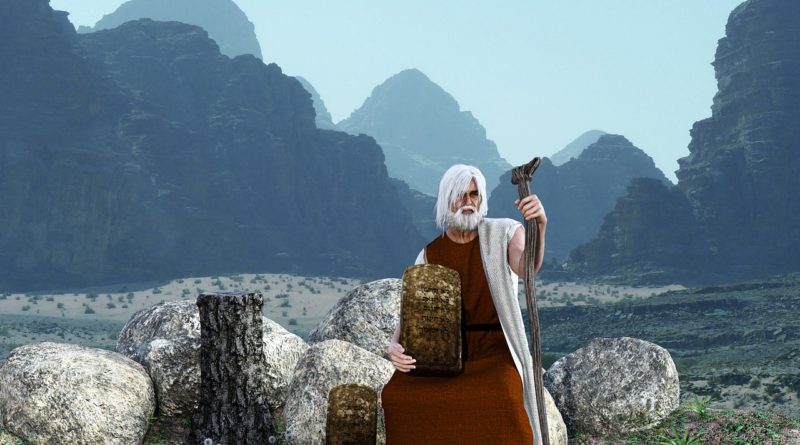Moses and the Bible’s Origins
By S. Douglas Woodward
Serious students of the Protestant Bible have a strong grasp of what the Bible teaches. But few know how we got our Bible and why we can trust that what it says today is what it said two millennia ago.
I argue that knowing about our Bibles is almost as crucial as knowing what’s in it.
My new book, A Biography of the Christian Bible: And How We Defend the Protestant Scriptures in the 21st Century, is a tour-de-force, 300-page history supplying what’s best described as a “biography” of the Bible —and how to defend its authenticity and accuracy against skeptics in the 21st century. It might be the most important book on the Evangelical view of the Christian Bible in a decade.
Today, many subscribe to the view that Moses was the inspiration for the Pentateuch, but he wasn’t really the author. Indeed, Israel’s ancient history and revelation was oral tradition passed down nearly 1,000 years before it was written down. I disagree and take a more conventional view.
But how did the primeval history of the Bible get written down? I answer that question in my new book.
“Many Christians have based their beliefs concerning the Bible on assumptions,” says Dr. Mike Spaulding, pastor of Calvary Chapel of Lima, Ohio, and host of Soaring Eagle Radio. “This has resulted in weak faith and arguments when confronted with contrary opinions from skeptics. In A Biography of the Christian Bible, Douglas Woodward addresses those assumptions and shows that it is possible, indeed critical, for Christians to understand how we received the biblical text, the chain of translations and their backgrounds, and why we can trust the manuscript evidence to lead us to the proper conclusions concerning biblical truth.”
The Pentateuch and the Role of Moses

Perhaps the first controversy that we come across in stalking the origin and destiny of the Bible is the historical figure, Moses.
Born a prince in Egypt, Moses would come to lead the Israelites from bondage – under the thumb of a tyrannical Pharaoh – to a promised land, full of “milk and honey.”
Moses was born an Israelite by race but was quietly adopted by the Pharaoh’s daughter. He was educated as a prince. Given the Egyptians had been writing in hieroglyphs for centuries before him, we can rightly assume he knew how to write with a “pictorial” alphabet.
However, his writing skills may have been influenced by utilizing a relatively new script, the basis for all alphabets today. And there is a reason to believe it was created by Joseph, the son of Jacob, who served as vizier for Pharaoh in Egypt’s Middle Kingdom (circa 1900 B.C.).
While some argue that the Hebrew language and its alphabet were provided by God to humanity and served as the original language, this view does not find many supporters in the academic world.
However, there was a common alphabet connected to Canaanites (the Phoenicians), Edomites, Ugarit, Aramaic, and Israelite (Hebrew) peoples. This script is known as “proto-Sinaitic” and also “northwest Semitic.”

Some conservative Christian scholars propose the language was invented in Egypt and was likely introduced by the Israelites into Canaan and the surrounding region after the Exodus (my date is circa 1588 B.C.).
Indeed, the cuneiform pictographs of Mesopotamia, as well as the Egyptian hieroglyphs, preceded a phonetic language by many centuries. (Note how the word phonetic derives from Phoenicia). However, as the movie, Patterns of Evidence: The Moses Controversy, by Timothy Mahoney presents, the agnostic Egyptologist, David M. Rohl, as well as the Christian theologian and archeologist, Douglas N. Petrovitch, propose the root language – the original script – borrowed pictures from the Egyptian hieroglyphs and married them to sounds in the Semitic language.
But even more specifically, to Hebrew – from a people originating in Canaan with the Hebrew patriarchs Abraham, Isaac, and Jacob. And Joseph also lived in Canaan and spoke Semitic until he was sold into slavery by his brothers.
Moses came to the decision point in his life, where he determined to adopt his “family” of Hebrews about the age of 40. The story goes that Moses would flee Egypt after killing an Egyptian and being threatened by his Hebrew brethren to “turn him in.”
He took up with a family in the desert, the land of Midian (today’s Arabia), headed by Jethro, who the account in Exodus indicates was Midian’s priest (Exodus 3:1). Soon he would marry one of his daughters, Zipporah.
Let My People Go!

After 40 more years and having a most interesting conversation with a burning bush where he talked with God, he returned to Egypt with the conviction that the God of the Hebrews had called him to liberate his brethren, still caught in the clutches of slavery, which by then may have amounted to well over one million Hebrews.
His dispute with a new Pharaoh eventually culminated in the liberation of the Israelites, thanks in part to the help of numerous great plagues God inflicted upon the Egyptians along with God’s mandate delivered through Moses, “Let my people go!” Based on such overwhelming signs and wonders, the Pharaoh relented.
Moses led his people from Egypt to Mount Sinai (likely in Arabia and not the Sinai Peninsula, see Galatians 4:25), where he received the Ten commandments. After receiving the decalogue, he led the people to the edge of the promised land, but the people were frightened by giants who inhabited Canaan.
Failing to find courage, they instead wandered through the wilderness for 40 more years. Many lessons were learned the hard way. And all the adult population when the Hebrews failed to “enter in” to the promised land, died in the wilderness.

Armed with new conviction, they won several decisive battles and eventually came up to the promised land of Canaan once more. However, the land was still full of giants who would not give an inch of the land to the Hebrews. They had no interest in handing over their cities, cattle, and property to the Hebrews.
So, the war for Canaan land began. Moses would not see the end of the war, and he would not “enter in.” He died viewing the land from a distance atop Mount Nebo. But before he died, he appointed Joshua to lead the multitude (Deuteronomy 31:23) and he completed writings that formed the basis of the Bible.
God had told him on several occasions to “write this on a scroll” (e.g., Exodus 17:14, 34:27, Deuteronomy 31:19,20). These were placed in the Ark of the Covenant along with the tablets of the Ten Commandments, a jar full of manna, their heavenly food while in the desert, and Moses’ brother Aaron’s rod that budded. (Deuteronomy 31:25). Thus, the books we know as Genesis, Exodus, Leviticus, Numbers, and Deuteronomy were received and retained.
Even many conservative scholars do not believe “that was the end of it” as others included more stories and added details, e.g., the account of Moses’ death would be of part of those elements not scribed by the great giver of the Law.

S. Douglas Woodward, Th.M., MA in Finance, is 64. He grew up in Oklahoma City, where he lives once again, after working in Boston for six years and Seattle for 21 years. Doug’s experience lies primarily in business information technology and financial management where he has served as an executive for Oracle, Microsoft, and a Partner at Ernst & Young LLP. He also founded his own consultancy for young companies, Smart Starters, which he managed for 10 years, before becoming Entrepreneur-in-Residence at the University of Oklahoma, Price School of Business, where he has taught classes in entrepreneurship for five years. Over the past seven years, Doug has become a nationally recognized author having written many books on the topics of America’s spiritual history, eschatology, theology, and geopolitics. His books of note include The Final Babylon, Decoding Doomsday, Power Quest (Books One and Two), Lying Wonders of the Red Planet, The Revealing, The Next Great War in the Middle East, Revising Reality, Rebooting the Bible and A Biography of the Christian Bible. He frequently appears on radio and television programs having been interviewed on over 100 different occasions on several dozen different shows. Additionally, he speaks at conferences concerning the multiplicity of topics about which he writes. Doug has two amazing adult children, an incredible daughter-in-law, two fabulous grandsons, and a beautiful wife, Donna, with whom he celebrates over 43 years of marriage. Discover more at www.Facebook.com/sdouglaswoodward and www.faith-happens.com.



